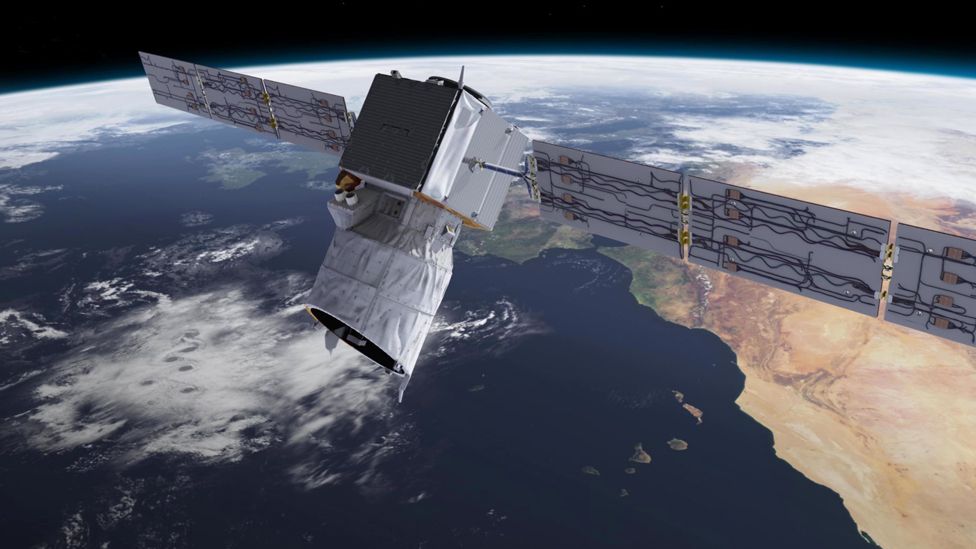A British-built spacecraft is expected to fall to Earth later on Friday, after completing a transformative mission to map the planet’s winds.
The Aeolus satellite fired a laser down through the atmosphere to track the movement of air in any location, at every altitude, all around the world.
Its success means replacements are already being planned.
But the project very nearly failed to get off the ground at all – because of the difficulty in making Aeolus work.
For more than a decade, engineers struggled to develop an ultraviolet instrument that could operate for long enough in the vacuum of space. And this delay led to Aeolus being dubbed “the impossible satellite”.
- Movies capture lightning spectacle across Earth
- Europe’s new weather satellite takes first photos
The engineers, under the leadership of the European Space Agency (Esa), stuck at it because of the prize on offer – the first truly global view of how winds behave on Earth, from the surface all the way up into the stratosphere (from 0-30km).
However, in the time it took for Aeolus to get to the launch pad, in 2018, and fly its near five-year mission, best practice for deorbiting defunct spacecraft had changed.
They now need the ability either to pinpoint their fall back to Earth to a safe zone or be sure of burning up completely as they come through the atmosphere.
And the more-than-one-tonne Aeolus fails on both counts. Its propulsion system is too weak to fully direct where it comes out of the sky and up to 20% of its hardware is likely to survive to the surface of the Earth.
Instead, Esa flight controllers have spent the week building up to an “assisted re-entry”. They have been commanding the satellite to lower its altitude in a series of manoeuvres, the last of which, on Friday, should drop it to a height of 120km (75 miles).
“At that point. the drag from the atmosphere should pull it down,” operations director Isabel Rojo tells BBC News. “We expect it to re-enter somewhere over the Atlantic Ocean, moving in a south-to-north direction.”

How to measure the wind from space

- Aeolus fired an ultraviolet laser through the atmosphere and measured the return signal using a large telescope
- The light beam was scattered back off air molecules and small particles moving in the wind at different altitudes
- Meteorologists adjusted their numerical models to match this information, improving weather forecast accuracy
- The biggest impacts came in medium-range forecasts – those that look at weather conditions a few days hence
- Aeolus played a critical role during the Covid-19 pandemic, replacing the wind data lost because aeroplanes were not flying
- Aeolus: Wind satellite weathers technical storm

Debris that does make it to the sea surface will probably comprise elements of the satellite’s graphite telescope and fuel tanks. But given the remoteness of the Atlantic, the risk to life is minimal.
Aeolus’s first-of-a-kind observations proved enormously helpful for medium-range weather forecasts. It tracked wind behaviours that would contribute to weather patterns days in the future.
Its work also improved knowledge of hurricanes and of how volcanic ash travels in the high atmosphere.
Before Aeolus, wind profiles were obtained via a hotchpotch of methods – from whirling anemometers, balloons and planes to the satellites that infer wind behaviour by tracking clouds in the sky or sensing the choppiness of ocean waters.
But these are all limited to particular places or heights, which is why Aeolus’s global perspective was so highly prized.

Esa member states have already approved a budget of €413m (£353m) to begin work on a pair of follow-up spacecraft named, appropriately, Aeolus-2.
A further financial contribution (approaching €900m) will come from Eumetsat, the intergovernmental organisation that manages Europe’s meteorological satellites.
The first of these follow-ons should launch towards the end of the decade.
And the UK’s Esa contribution, €71m, combined with its big subscription (16%) to Eumetsat, means the British arm of aerospace manufacturer Airbus will probably lead the production of the spacecraft once again.
Related Topics
- Earth science
- European Space Agency
- Space exploration

